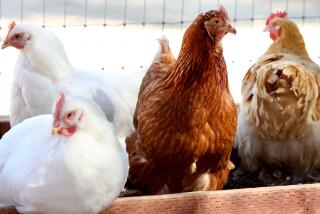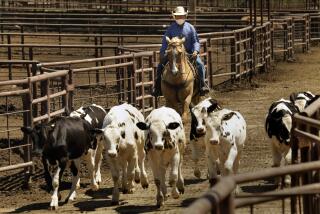How the Midwest drought could help curb obesity
“Midwest drought worsens, threatening food prices,” warns Michael Muskal on Nation Now. With the drought spreading across the Midwest, drying up the land and damaging crops, the price of what’s salable has started to climb. Of biggest concern: corn and soybeans.
“Corn prices have spiked 20% in the past month, while soybean prices have jumped 15%,” writes Aaron Smith for CNN Money. And you know what feeds on corn? Livestock.
“Corn futures -- contracts for commodities to be delivered later -- have jumped almost 50% since the beginning of June and are at the highest level in more than a year. December corn now costs almost $8 a bushel, compared with just over $5 a bushel four weeks ago,” explains Ricardo Lopez in The Times Business section. What that means for farmers? In the present it means that they’re slaughtering more of their livestock now so as not to feed them; we may even see the cost of meat drop for a moment. Later it will mean they’ll have less supply, at which point consumers will really feel the pinch at the grocery store.
“Our crop failure isn’t what keeps me awake at night these days; it’s worrying about our animals. No crops means no feed for livestock,” writes Chris Chinn, a family farmer, on CNN’s opinion section. “We can’t stop feeding cattle and hogs. We own 60 head of cattle, and our family has 1,500 sows on our farm. Bountiful crops are needed for an adequate feed supply, but so too are healthy pastures for cattle grazing. Both need rain. […] The bottom line is: If you eat, this drought will affect you.”
Of course, it’s not just meat we have to worry about. Given that corn is engineered into so much of what we consume, the USDA predicts overall food prices will rise about 3.5% by the end of this year.
Given that, perhaps it’s time to curb our appetite for corn -- and the meat and milk from animals that feed on it too -- and start consuming the vegetable the way nature intended before President Nixon stepped in and turned into a commodity for super profits. (See “Blame Nixon for the obesity epidemic.”)
Dr. John McDougall, who advocates for a plant-based diet, agrees. “One effective solution for individuals, as well as the nation at large, is to change people’s eating habits. Rather than feeding the crops to animals we could instead eat the corn, wheat, soybeans, and potatoes ourselves. The savings would be world changing,” he told The Times over email. Citing stats from his new book, “The Starch Solution,” he continued: “It takes about 7 pounds of edible, healthy grains to produce just 1 pound of beef, 4 pounds for a pound of pork, and 2 pounds for a pound of chicken. Reallocating land from animal to crop production would increase our food resources at least seventeen-fold: Crops like potatoes can produce 17 times the calories as animals on the same piece of land. There would be additional positive consequences of replacing animal foods in our diet with plants.”
But the burden of responsibility and change shouldn’t fall just on consumers. The Department of Agriculture should get on board too. In a recent Opinion piece about the ills of dairy produced by corn-eating cows, the New York Times’ Mark Bittman wrote that “the job of an agriculture department should not be to sell whatever crops our farmers can grow most efficiently, it should be to encourage the growth of crops that will benefit the greatest number of Americans. Those crops are not corn and soy, grown largely to create hyper-processed food or animal feed (and in turn animal products), but an increasing variety of plants that can be directly eaten by humans.”
ALSO:
McManus: In politics, accentuate the negative
Think Obama’s a Muslim? Then you’re too stupid to vote
Follow Alexandra Le Tellier on Twitter @alexletellier. Follow Opinion L.A. on Twitter and Facebook.
More to Read
A cure for the common opinion
Get thought-provoking perspectives with our weekly newsletter.
You may occasionally receive promotional content from the Los Angeles Times.






